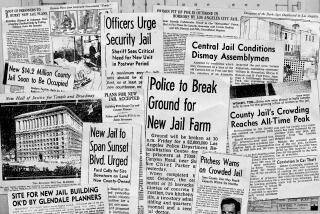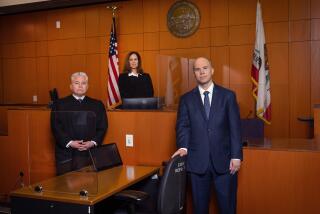Superior Court Judges Hint of Downtown Exit
- Share via
Squeezed for space and frustrated by a decade of inaction, San Diego County’s Superior Court judges say they reluctantly are ready to launch a wholesale exodus of court activities from downtown San Diego into surrounding cities.
The judges, who for years had resisted calls to decentralize the court, voted unanimously last month to place courtrooms wherever developers or municipal officials can package together enough money to build them--even if the projects mean litigants will have to travel far out of their way to get their day in court.
Though they would like to stay downtown, the judges say they are prepared to transfer virtually all civil court functions out of the central city if San Diego fails to come forward with a plan to compete with outlying areas that are salivating at the prospect of becoming major centers of legal activity.
“We’re out of space now,” Superior Court Presiding Judge Thomas Duffy said in a recent interview. “So any place we can get court space to try cases and accommodate the people of this county, we’re going to do it.”
Courthouse construction projects already are being hatched in Escondido, El Cajon and Chula Vista, with each city viewing a Superior Court branch as the attraction that will draw law offices, insurance companies and foot traffic to downtown redevelopment districts.
But San Diego business and political leaders--who only in recent weeks have begun to learn of the judges’ plans--are equally fearful of the damage that could be done to downtown’s revival if a significant portion of the Superior Court’s workload flees to other cities.
Major Problem
“It is a major problem for the health of downtown,” said Gerald Trimble, executive director of the Centre City Development Corp., the city’s downtown redevelopment agency. Developers would have trouble finding tenants for new buildings, he said, and vacancy rates in existing buildings would mount.
“There will be a mass exodus of civil trial lawyers as well,” added San Diego County Bar Assn. President Daniel Broderick III, who termed the possible dispersal of court services “an unmitigated disaster.”
“I’ll guarantee I’m not staying downtown next to the courthouse if there isn’t any work for me down there,” he said.
Still, court leaders complain that the City of San Diego has been slow to awaken to what they insist is a real possibility, and not just a threat, that downtown will end up as home only to a Municipal Court, a decrepit county jail and the Superior Court’s criminal departments--functions that generate less business activity than do civil courts.
Judge Barbara Gamer, who chairs a Superior Court planning committee, said court officials had to call twice to City Hall to wangle an appointment with Mayor Maureen O’Connor--and then were told that the mayor could not squeeze them in until late September.
“Sometimes I think the mayor of the City of San Diego is more interested in getting funds for the America’s Cup and the Super Bowl and the Holiday Bowl than she is in trying to accommodate the public, as far as Superior Courts are concerned,” Judge Duffy said in frustration.
Paul Downey, O’Connor’s spokesman, insisted that the mayor’s office told the judges that O’Connor would rearrange her schedule to see them sooner if the meeting was urgent. O’Connor recognizes the importance of keeping the courts downtown, Downey added, and looks forward to working with the judges to that end--within the tight constraints of the city’s budget.
Complicated Debate
“The mayor would like to keep the courts in downtown,” he said. “They play an important part in the atmosphere of downtown San Diego. She is open to listening to the alternatives the judges might have when they come in to meet with her.”
The debate over court expansion--both where new courts will be located and how they will be paid for--is far older and more complicated than a petty squabble over the timing of a meeting with the mayor. It last came to a head in the late 1970s, when the Superior Court took a stand in favor of concentrating its activities in downtown San Diego, rather than branching out into other cities.
The court, Duffy noted, went so far as to persuade the County Board of Supervisors to chop space for a branch court out of plans for the East County Regional Center in El Cajon. Meanwhile, budget cuts provoked by Proposition 13 axed Superior Court space from the plans for the South Bay Regional Center in Chula Vista.
Almost immediately, however, rapid growth in the outlying areas began to turn the tide in favor of a Superior Court presence in the suburbs. A thriving branch court in Vista proved that decentralization could work. Former Municipal Court judges from suburban courtrooms formed an ever-larger bloc on the Superior Court. And Assemblyman Larry Stirling (R-San Diego) pushed a bill through the state Legislature in 1984 mandating that El Cajon and Chula Vista receive their first Superior Court judges.
In the meantime, study after study was being conducted downtown on ways to address the growth needs of the court. Consultants proposed construction of a high-rise building adjacent to the existing courthouse, renovation of the courthouse to create space for more courtrooms, and leasing of buildings to house the domestic and probate courts.
Tax Increase Rejected
All the studies agreed that the need countywide for more judges and courtrooms was immense. To keep up with swelling civil and criminal caseloads, according to one planning report, the county would need 51 to 78 Superior Court judges downtown by the year 2005. Now there are 35. Vista would need 25, where now there are 10. El Cajon would require 11 to 16; now there are two. Chula Vista would demand 8 to 12; now there are none.
Reconfiguration, renovation and leasing have created additional courtrooms in San Diego. But with the rejection by voters in November of a 0.05% sales tax for jails and courts, the county has been unable to find the funds for the $210 million in major construction projects that experts have said are needed.
Without space to house them, the Superior Court--already about 40 judges shy of the number the state Judicial Council says it needs to meet its burgeoning workload--cannot add judges, even when the county finds the money to pay their salaries.
Repeated Interruptions
The shortfall means that criminal cases, which by law must proceed on a strict timetable, squeeze civil cases out of court. Civil lawsuits can take more than five years to come to trial, Gamer noted. Many are repeatedly interrupted when judges must turn to criminal matters, wasting the time of clients and lawyers, and adding to the clients’ costs.
“If you are a civil litigant paying a lawyer $100, $150 or $200 per hour and have experts being paid $2,000 a half-day, and you’re told out of the blue at 10 in the morning, ‘Sorry, we’re putting you on the back burner for 10 days while we handle this criminal trial,’ it’s a very costly and frustrating process,” Gamer explained.
So when builders and mayors in several cities this spring began proposing courthouse construction plans requiring minimal investment by the county, the judges--and some county supervisors--were more than ready to listen.
“Anybody with any eyes in their head will see that the county can only afford to put facilities where people make it economically viable,” said Brian Bilbray, chairman of the Board of Supervisors, whose district includes downtown San Diego.
The plans are at varying stages of development:
- Lusardi Construction Co. has proposed building a 10-story, $30-million courthouse and a $20-million office tower across the street from the Civic and Cultural Center being built in downtown Escondido. The project would provide space for 50 courtrooms and could satisfy the city’s obligation to provide a building in exchange for tax revenue the county is losing in Escondido’s redevelopment zone.
The project would meet North County’s courtroom needs for the next 20 years--but only barely, according to Superior Court Executive Officer William Pierce.
- The City of Chula Vista has promised the county $1.3 million, and could make available as much as an additional $1.1 million, to build four courtrooms for the Superior Court in the South Bay Regional Center. City officials also are ready to discuss a bond issue to construct a free-standing Superior Court building at the regional center, Mayor Greg Cox said.
“The City Council in Chula Vista has felt very strongly we want to have Superior Courts in this facility,” he said. “It’s going to be an added boom to our downtown redevelopment effort, by providing additional shoppers and office-space occupancy in the downtown area.”
Cox warned his municipal competitors in San Diego that they seem asleep at the wheel. “Downtown San Diego, I think, has got to wake up to the fact they’ve got to provide some assistance to the county if they’re going to maintain some Superior Courts in the downtown San Diego area,” he said.
- The El Cajon City Council voted earlier this month to expand the city’s redevelopment zone to include the area surrounding the East County Regional Center. As in Escondido, the city has talked with county officials about working with a private developer to build a courthouse as compensation for the tax revenues the county will lose in the redevelopment area, Mayor John Reber said.
An expanded Superior Court presence in El Cajon “would bring more people into the older downtown area,” said Reber, confirming that one site under consideration is the Target shopping center just north of the regional center. “That’s what you want when you have a redevelopment project.”
According to Reber, the Superior Court’s expansion needs should allow it to add facilities both in downtown San Diego and in other cities. He doubts there will be a court exodus at the expense of downtown, but says the consequences would be dramatic.
“If that ever happens, I think San Diego will become a ghost town,” Reber said.
Suburban Advantages
All of the suburban proposals share qualities that court and county planners find attractive. Land will cost less than in downtown San Diego, parking can only be easier and--for some county residents--an outlying location will be more convenient to reach than the downtown courthouse.
Nonetheless, court officials say they would like to be able to keep court activities massed downtown. Centralized courts can be run more economically and efficiently, they note. The judges, moreover, do not want to be responsible for the wrenching economic dislocation that the suburbanization of the courts would create. And they realize that placing courts where developers will build them does not guarantee that the courts will be where they are most needed or convenient.
But economic realities dictate that the courts go where they can cut their best deal, the judges and county officials insist.
“People in this county have a right to have their cases heard in a timely fashion,” Gamer said. “If we can’t meet those needs staying downtown, we’ll move elsewhere.”
There are efforts under way to keep downtown San Diego in competition for a leading role in the courts’ future.
Proposal Studied
City and county officials are studying a proposal by Starboard Development Corp. for construction of a 22-story office tower west of the downtown courthouse that would house about 20 courtrooms on its lower floors.
Starboard’s goal “is to come up with an alternative that is cost-effective and would put the option of downtown on equal footing with any other option available to the county, so they can stay downtown with their existing infrastructure,” said G. Bradford Saunders, president of the development firm.
“The proposals in the outlying areas are what’s making everybody realize something has to happen downtown,” Saunders said.
CCDC’s Trimble said he will recommend that the redevelopment agency assist Starboard in financing the project, perhaps through a commitment of tax-increment financing, as is under consideration in Escondido and El Cajon. Such participation by the City of San Diego would be a landmark in the local history of financing the criminal justice system.
“I’m going out on a limb on this,” Trimble acknowledged, “but it’s important enough to downtown that I’m willing to take that leap out on the limb a little bit.”
Gamer said she also has talked to Trimble about designating a square block just west of the downtown courthouse as a redevelopment site for construction of a courthouse extension. And the proposal from a 1985 consultant’s report for construction of a high-rise tower just north of the courthouse remains an option, she said.
Working on Measure
Stirling, meanwhile, is working in Sacramento for passage of a measure that would allow San Diego to return the 0.05% sales tax proposal to the ballot, but this time requiring only a simple majority, rather than a two-thirds margin, for passage. A sales-tax hike, county officials agree, would be the easiest and most direct way to finance court and jail construction, allowing the county to place facilities where they make most sense rather than auction them off to the highest bidder.
With the availability of tax revenue remaining uncertain, though, the judges are lobbying council members for city action to help the Superior Court and are seeking support from the downtown business community for a public-private partnership to keep the courts downtown.
But San Diego clearly is playing catch-up.
“If the City of San Diego doesn’t start moving forward and coming up and trying to assist the county in this problem,” said Pierce, the court executive, “the other areas may be so far along they may be left out in the cold.”
More to Read
Sign up for Essential California
The most important California stories and recommendations in your inbox every morning.
You may occasionally receive promotional content from the Los Angeles Times.










